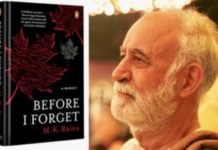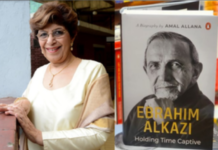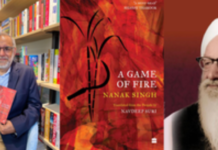By Vishnu Makhijani
New Delhi– Ace photographer Raghu Rai was only five years into the profession when the Bangladesh liberation struggle erupted in March 1971. He was dispatched post-haste by The Statesman newspaper to record the exodus of refugees, they would eventually number some 10 million, as they streamed into West Bengal and neighbouring states to escape the atrocities being committed by the Pakistani Army.
He could immediately empathise with the refugees being a child of Partition himself when he and his family were uprooted from their Jhang hometown in what is now Pakistan.
Rai worked at a furious pace sending back images after images which the newspaper faithfully carried, making him a household name in India and unfolding the horrors that marked the liberation struggle. But then, tragically, his entire body of negatives was lost, till they were recovered, quite by accident.
The outcome is “Bangladesh: The Price of Freedom”, published by Niyogi Books to mark the 50th anniversary of the creation of Bangladesh as an independent nation.
“I got involved myself in the sense that in 1947, when my family and I were uprooted from Pakistan, we came to India as refugees. Because the newspaper needs one or two pictures every day, my own environment and being a refugee myself, I got involved watching the plight of the refugees from East Bengal and their sufferings. And then these negatives were lost. They were put into some big bundle somewhere and never saw the light of the day,” Rai told IANS in an interview.
“Then suddenly one day my assistant, who was scanning my important photos, said, �Here is this packet of photos of Bangladesh refugees’. And I said, �Really?’ This was after 40 long years that we discovered it.
“Meanwhile, you know, many photographers from around the world had come and taken pictures of Bangladesh refugees, like Don McCullin from the Sunday Times had done a feature, a very good feature. And I thought, �What a great job he’s done!’ And then he had done a quick book and I said, �Very good!’ And I had forgotten about my own work. And then I see my work after 40 long years, and I said, �My God, it has its own intensity and message that needs to be shared. So then, I spoke to the relevant people and that’s how the book came about,” Rai explained.
What were his thoughts as he once again studied the images and made the selections for the book?
“You see, there were two really important points, one is that in 1971�72, I was just five-years-old as a photographer. I was madly, deeply involved. But I was so young as a photographer and then I had seen the work of Don McCullin and, you know, he was 11 years senior to me. And then I discovered my photos and compared my work. And I thought, �Let me put it out in the public domain because I have done it’.
“So I discovered that even if I was only five-years-old as a photographer, the intensity and the suffering that I had managed to cover was so powerful and moving that I thought I must share this,” Rai elaborated.
And what an era this recreates! The stories are perhaps not unknown, but are retold by a master storyteller � the refugee camps, the exodus, the never ending journey, a whirlwind of poignant, tormented history. And finally, a new nation, a new tomorrow. “Bangladesh: The Price Of Freedom” contains never before seen photographs which comprise a significant body of work documenting a turning point in the history of South Asia � by someone who was there from the beginning to the end.
In the final denouement, after General Sam Manekshaw, ordered the army to move into action on December 4, 1971, Rai drove with the first column that headed the attack, towards Khulna through Jessore Road, which the Pakistan Army had already abandoned.
“The first 40/45 kilometers were easy but then, as we got closer to the Khulna sector, we were greeted by artillery fire with airburst � their artillery was locating the enemy with the help of informers on wireless and closing in on targets. We were located and ambushed � the airburst caused casualties, as we were moving in the open,” Rai writes in the book.
“I photographed some of the wounded soldiers being taken away. But the question was how many such photographs could I possibly take? The next set of victims could be us. The major who was conducting me wanted me to move to safety. We ran for half a kilometre in a �safe direction’. I saw a chai shop and relieved, ordered tea and biscuits, pleased that I had a close encounter of an actual war, had taken action photos and escaped! I was stretching myself on the road when one bullet flew past me. The major shouted for me to lie down. I did � and another bullet went past me. I crawled back to the shop and was told by the shopkeeper that the Pakistan Army was on the other side of the rail track, just half a kilometre away.
“This was probably the shortest war fought and won by any nation. This was also due to the fact that the local population in Bangladesh had become hostile to the Pakistan Army. The Indian Air Force did the rest. By day 12 of the war, on December 16, 1971, 93,000 Pakistani soldiers had surrendered to the Indian Army.
“I flew into Dhaka in an army helicopter to witness scenes of jubilation and humiliation � of victory and surrender. Indira Gandhi’s bold decision, General Manekshaw’s masterstroke and General Jacob’s strategic planning had brought an end to nine nightmarish months of brutality and terror � rapes, torture and dehuamnisation of Bangladeshis � the price they had to pay for their freedom,” Rai writes.
This book is one of four being published by Niyogi Books to mark the 50th anniversary of the Bangladesh war.
“The liberation of Bangladesh in 1971 was like a geo-political earthquake. No sensitive person in publishing or in any other profession could avoid its huge ramifications. As a publisher, we thought of documenting this event through different books because of an inner urge. There was no grandstanding or expectation of a future commemorative event. This is how the books � �Bangladesh:The Price of Freedom’, �Sheikh Mujibur Rahman’ and �Blossoms in the Graveyard’ came about,” Trisha De Niyogi, COO and Director, Niyogi Books, told IANS.
“Simultaneously we are bringing out a unique book to commemorate the celebration. This is a first-hand report by a rookie Calcutta journalist from The Statesman, who accompanied the Mukti Bahini fighters at different places in the then East-Bengal. Later on, he also trailed the Indian Army when the latter got seriously involved in the liberation War. The book is titled as �Bangladesh Liberation War: Report from Ground Year’ and the writer is Manas Ghosh,” Niyogi added.(IANS)














